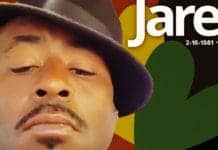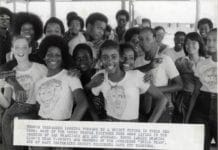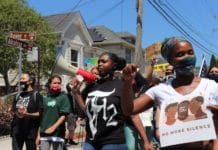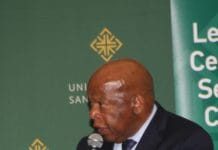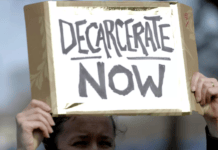From Oakland to Santa Rita, the struggle continues
by George Ciccariello-Maher
‘Town Bizness’

The place was the historic Black Dot Café in West Oakland; the event, a “Town Bizness” town hall meeting hosted by the Prisoners of Conscience Committee (POCC) with the presence of Chairman Fred Hampton Jr. and a crowd that spilled out the door. “This ain’t like the other town halls where a preacher talks for three hours,” said POCC Minister of Information JR by way of introduction, in oblique reference to the weekly meetings held at Olivet Baptist Church.
Those gathered at the Black Dot were among the few organizations and individuals still insisting, with the unequivocal support of all the events that had come to pass in recent weeks, that organized rebellion in the streets had been fundamental in the arrest of Johannes Mehserle for the murder of Oscar Grant. Many of those present took aim at the “opportunists” and the self-appointed leadership which, by virtue of city contracts and non-profit status, had been perceived as hijacking a city’s anger and turning it down the path of institutional power – some hoping, no doubt, to ride the masses all the way to elected power themselves. As an alternative, those gathered at the Black Dot agreed on a list of demands, and on a strategy of mobilizing for the bail hearing of Johannes Mehserle, to be held on Jan. 30.
New video, new pressure
But in the intervening days, the political balance of forces had shifted dramatically, with the legitimacy of both the BART police and the OPD seemingly in free-fall. First, it was announced that the head of OPD internal affairs, Ed Poulson, had been suspended and that the FBI is currently investigating the force over the death in custody of Jerry Amaro some nine years ago. This, combined with a threatened no-confidence vote for Police Chief Wayne Tucker partly over handling of the investigation into the murder of journalist Chauncey Bailey, led Tucker to announce his unceremonious resignation, leaving a gaping power vacuum at the head of this force, which would make itself felt later.
In addition, BART Police Chief Gary Gee, who seems hell-bent on infuriating the public as much as is humanly possible, was circulating a memo instructing all BART officers on how they could show their solidarity with Mehserle by making a donation to his defense. “You have our full support,” writes Gee, who went on to blame “public abuse and the media’s reporting” for placing undue stress on his department. As Grant family attorney John Burris put it, “It is unacceptable for the police chief, who ostensibly is investigating Mehserle and other officers, related to their conduct on the night that Oscar Grant was killed, to encourage officers to visit and make financial contributions to Mehserle.”
But perhaps the most important element in this new upsurge in public anger and disillusionment with the police was a new cellphone video release by KTVU news, and taped on the BART platform the night Oscar Grant was executed. The recording shows a different officer, now identified as Tony Pirone, who would later have his knee on Oscar Grant when he was shot by Mehserle, punching Grant in the face for no apparent reason, and clearly escalating the tone of the situation. While those in the streets have been demanding the arrest of the other officers as accessories to murder, this demand had been largely ignored until it gained a degree of tangible reality in that video, at which point BART officials announced an investigation would be opened.
‘We fired up, can’t take it no more’

Inside the hearing, Mehserle’s newly-contracted attorney, Michael Rains, who previously got corrupt OPD officers off in the Riders case, was making the case for bail. Mehserle had yet to open his mouth about what happened that night on the BART platform, a refusal that many interpreted as individual cowardice given the protests rocking the city. But if he wanted bail he would have to say something and, in the end, that “something” was not convincing at all.
Mehserle’s lawyer simultaneously suggested that Mehserle meant to deploy his Taser against Grant, while adding that he thought Grant was reaching for a gun. Again, both claims have been thoroughly discredited: Mehserle had removed his Taser, which bears no resemblance to his gun, from the opposite side of his belt earlier, and Grant was face-down with Pirone holding his neck, showing no signs of struggle.
Moreover, if Grant were reaching for a gun, surely Mehserle would admit to purposefully pulling his own weapon. But there was a method to this madness, and it was this: Mehserle had to mention the Taser defense to leave open the possibility of a reduced charge, but he had to add that he thought Grant may be armed to leave open the possibility for a total acquittal under the tried-and-true police defense of “justifiable homicide.”
Luckily, Judge Morris Jacobson noticed the ambiguity and wasn’t buying it: Mehserle, Jacobson acknowledged, did indeed represent a flight risk, and his contradictory story made him a potential danger to the community. However, under California guidelines, and since this was not a capital murder case, the judge nevertheless granted Mehserle a bail of $3 million. But concealed beneath this seemingly “technical” bail decision was a more important one: Certainly, Mehserle has not been charged with a capital offense, but this is because he was white and a cop to begin with.

Immediately, those gathered took up positions to block the exits to prevent Mehserle’s departure, with chants of “No justice, no peace! Fuck the police!” But after a few minutes, they set out on a march that would retrace the path of the street rebellion some three weeks prior. The crowd of around 100 surged up 14th to Broadway, where the intersection was closed and an AC Transit bus taken over, with a protester addressing the crowd from the roof.
After a few minutes, we moved down Broadway toward the OPD station and, as we arrived, a small contingent of police was hurriedly setting up a cordon to protect their home. After a brief standoff, the crowd began to move back up Broadway, by now 150 strong as passers-by and young students spontaneously joined in. Now, the chant was “We fired up, can’t take it no more!”
As we stream past vehicles, some notice a small, unmarked SUV full of cops, and the crowd showed its contempt in no uncertain terms. From a few feet away, I saw the rear window of the vehicle explode, revealing an officer pointing a rubber-bullet gun from inside the vehicle. Immediately, half a dozen flash-bang grenades were lobbed into the crowd, weapons which even the manufacturers admit are deadly and should only be used as a last resort.
Now, of course, they were used as a first resort, and several protestors were on the ground screaming for medics from the impact of the explosions. People scattered, taking refuge behind cars as the officers climbed out of the vehicle, each tossing several more grenades in all directions to disperse the crowd.
‘I’m gonna fuck you up’

To be clear: No order to disperse had yet been read, and we were in the parking lot of a private business. As the crowd approached the police line, a fairly massive Black officer named Smith began to taunt a much smaller demonstrator, urging him to give the cop reason to arrest him. When no reason was forthcoming, Smith grabbed the young man by his bandana and threw him into another officer, who then proceeded, along with some comrades, to brutally pound the young man and his friend for a number of minutes. When the crowd began to loudly protest the brutality they were witnessing, the cops made their intentions clear. As Smith himself promised me with a swipe of his baton: “I’m gonna fuck you up.”
And it wouldn’t be long before this hefty soldier made good on his promise. About 20 minutes later, after a dispersal order had been read at another intersection, the crowd was ordered to move to the sidewalks and, as a friend and I crossed a crosswalk – with the light green, no less – Smith and friends saw their chance.
My friend was tackled from behind, his forehead smashed into a light pole. I hadn’t taken but two steps toward him when five officers flattened me. Skillfully navigating the avenues of pain and skirting the fine line separating a broken bone from a soft tissue injury, these portly knights of order made the most of their 30 seconds of absolute sovereignty, twisting and wrenching shoulder, elbow, wrist and individual finger, kicking and punching me in the face and back.
In the back of the wagon, we were a sorry looking lot, my friend bleeding profusely from the forehead, and one of the McDonald’s arrestees with a smashed nose. Our cellphones had been confiscated as “evidence” – as this article is published, we are told that these will not be returned until we consent to police downloading their contents.
Our transporting officer, Miller, immediately promised that we were all “CRs,” cite and release, so no worries, we would be out soon. This, of course, was a lie for all but one, but it served another purpose: If any of the arrested wished to complain about excessive force and injuries – we all had suffered excessive force and were all injured to some degree – we would need to be transported to Santa Rita County Jail, where we would be spending the night so as to receive “proper treatment.” Such was the blackmail to prevent complaints.
Around the same time, we overheard an officer speaking to several Black juveniles in the compartment in front, in a display of unmitigated racism urging them to hand over any “crack pipes” or weapons they might have. And in response to several officers persistently referring to him as a “body,” a Latino minor shouted angrily and in disbelief, “I am not a body! I am a human being!”
Preaching at the bully pulpit

This began with the case of Oscar Grant himself, who a vast majority of the public agree was brutally murdered by BART cop Johannes Mehserle. All the fine Miller had to say was that “the media played a large role in the problem.” Evidently, “the problem” was the fact that Mehserle had been arrested, not that Grant had been murdered.
To claims of racism, both against Grant and as an unspoken rule of policing, he appealed to demographics: Sure, in Oakland his drug arrests were mostly of Black and Latino men, but when he had worked in (mostly white) Hayward, he arrested mostly whites. Only the barest of logic is necessary to convince someone of something they already believe.
I brought up the 2007 murder of Gary King, shot in the back on Miller’s own beat as he fled. He insisted that while many argued King didn’t have a gun, he was sure that he did, and not just that, but he was “going for it.” When I asked how he could possibly “know” that there was a gun and, more to the point, “know” that King was “going for it,” when only Pat González, the murdering officer, was present, the debate is over: He mutters “justifiable homicide” and changes the subject. We are quite simply speaking different languages.
Still worse was the lengthy lecture one imprisoned protester was given at fingerprinting. A young cop, insisting that he defends the right to protest, launched into a condescending explanation of the lessons of Martin Luther King Jr. It was tempting to point out that he had clearly failed to grasp the dynamics of the Civil Rights Movement, the necessary dialectic of militancy and nonviolence, of MLK and Malcolm, that had driven political change.
It was tempting to suggest that someone in his position 50 years ago would likely have seen King as a communist and a terrorist, and most certainly as violent, as was the public perception and press portrayal before the Black Power Movement entered the scene and liberals rushed to the cause of moderate change. It was tempting, too, to note that the government and even some clergy turned again on King near the end of his life for his increasingly radical views and criticism of the Vietnam War and capitalism, reserving for this prophet of nonviolence an assassin’s bullet. But concrete walls, uniforms, and guns don’t generally make for productive debate.
When one of the arrestees requested food after being held for nine hours, the response was gleefully insulting: “You should always make sure you’re full if you’re gonna get arrested,” one officer chirped with proud condescension. “Maybe next time you should stop at Chili’s on the way to the protest.”
‘Damn, another Santa Rita weekend’ – The Coup
At around 3 a.m., after being systematically shifted between holding cells for more than nine hours to cultivate disorientation and prevent what little sleep was possible on a concrete bench or a filthy floor, we are transported to Santa Rita. They had lied to us about citing and releasing us and, without reading us our rights, without even telling us we were arrested, without telling us what the charges were or the bail amount, we were shipped out.
There, the holding cell is even filthier and, while we are the first to arrive, by 8 a.m. the room is full to capacity with some 30 new inmates. Most, it seems, were grabbed on incorrect warrants or bogus charges that are unlikely to stick, but it doesn’t matter much: For those unable to post bail or bond, there is little recourse, and many were resigned to spending a month or at least a “Santa Rita weekend” at the facility only for the charges to be dropped or to be found innocent. There’s no presumed innocence when you’re poor.
As day breaks, we are issued our 2XL county blues and fish-kits and, as we are preparing to be moved yet again, we begin to discuss the Oscar Grant case. Unsurprisingly, everyone in our holding cell knows about it; everyone has seen the video. Even less surprising, perhaps, is the fact that everyone knows what side they are on.
One Latino inmate stands on the bench and begins an impromptu speech: “What we need to do is to attack the code of silence that binds these cops to each other. They know who kills who, and we need to get them to snitch on each other. That’s the only way we’ll get justice.” He ends his speech by advocating a generalized and indefinite hunger strike until the other officers on the platform when Grant was murdered are arrested as accessories to the crime.
After inmates are strip-searched, we move into the general housing unit bunk areas, or “pods.” We are disoriented from lack of sleep, but as soon as our pod-mates find out what our charges are, their support is immediate and unwavering. When I mention that I’m a writer, it is not but a few short moments before I am handed the small pen and the disheveled stack of paper with which I am writing this very document. “At least you in here on some real shit,” one remarked, fist in the air.
George Ciccariello-Maher is a Ph.D. candidate in political theory at UC Berkeley. He lives in Oakland and can be reached at gjcm@berkeley.edu.

 Store
Store



